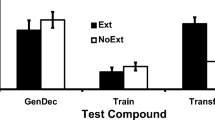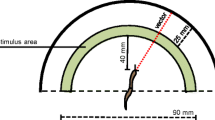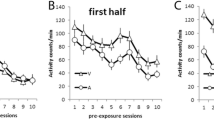Abstract
Ten rats were deprived of water and trained to lick a tube for saccharin reinforcement. In each of the two sessions that followed, the rats received six contiguous pairings of a 30-second illumination of the houselight and a 0.75 second, 0.10 mA electric shock while licking. No sign of conditioning was observed during the first experimental session, but profound conditioning was observed on the first and subsequent trials of the second conditioning session. No comparable change in the rate of licking was observed in groups of rats that received only presentations of the visual stimulus, only presentations of the electric shock, or random presentation of the visual stimulus and electric shock during the first conditioning session. These data establish that the incubation of conditional suppression is an associative phenomenon.
Similar content being viewed by others
References
Anisman, H. (1975) Time dependent variations in aversively motivated behaviors: Nonassociative effects of cholinergic and catecholaminergic mechanisms.Psychological Review, 82, 359–385.
Bryan, R. G., and Spear, N. E. (1976) Forgetting of a discrimination after intervals of intermediate length: The Kamin effect with choice behavior.Journal of Experimental Psychology: Animal Behavior Processes, 2, 221–234.
Bunch, M. E., and Magdsick, W. K. (1933) The retention in rats of an incompletely learned maze solution for short intervals of time.Journal of Comparative Psychology, 16, 385–409.
Eysenck, H. J. (1981) Behavior therapy and the conditioning model of neurosis.International Journal of Psychology, 16, 343–370.
Pinel, J. E. P., and Mucha, R. F. (1973) Incubation and Kamin effects in the rat: Changes in activity and reactivity after footshock.Journal of Comparative and Physiological Psychology, 84, 661–668.
Randich, A., and Rescorla, R. A. (1981) The effects of separate presentations of the US on conditioned suppression.Animal Learning and Behavior, 9, 56–64.
Rodger, R. S. (1974) Multiple contrasts, factors, error rate and power.British Journal of Mathematical and Statistical Psychology, 27, 127–198.
Rodger, R. S. (1975a) The number of non-zero, post-hoc contrasts from ANOVA and error-rate, 1.British Journal of Mathematical and Statistical Psychology, 28, 71–78.
Rodger, R. S. (1975b) Setting rejection rate for contrasts selected post-hoc when some nulls are false.British Journal of Mathematical and Statistical Psychology, 28, 213–232.
Author information
Authors and Affiliations
Additional information
Supported by NSERC University Research Fellowship U0262 (WJJ) and a studentship from the Medical Research Council of Canada (JRB).
Rights and permissions
About this article
Cite this article
Jacobs, W.J., Blackburn, J.R. Incubation of conditional suppression is an associatively-based phenomenon. Pav. J. Biol. Sci. 22, 118–121 (1987). https://doi.org/10.1007/BF02734665
Issue Date:
DOI: https://doi.org/10.1007/BF02734665




